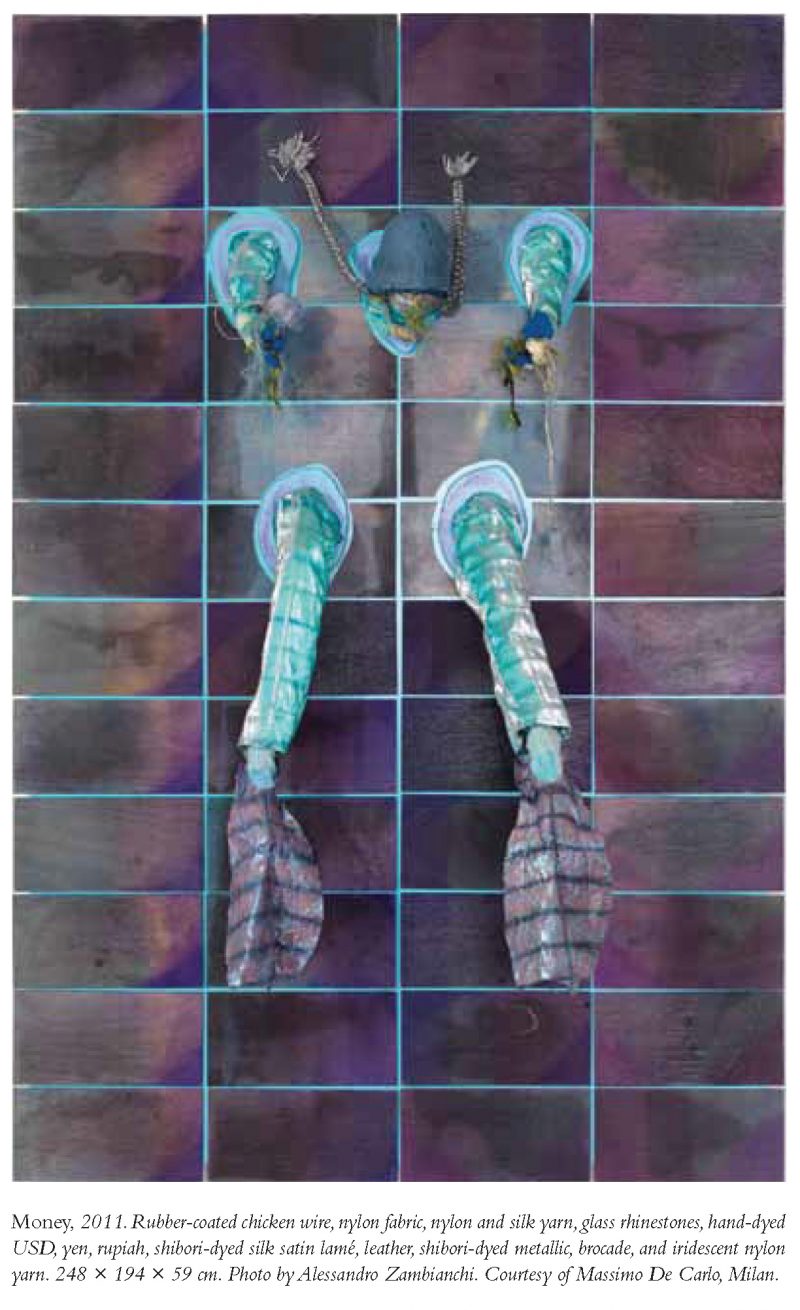Christian Holstad’s practice is broad and includes ornate collages, artfully erased newspaper photographs, enigmatic installation works, and cloth assemblages. With materials that are usually modest and simple, he expresses a strikingly alien experience of civilization. He often evokes political subversion, but never attempts to carry the burden of a clear-cut message or heavy-handed position. We discussed his new sculpture Money over several email exchanges in the spring of this year. Holstad was born in 1972 and lives in New York.
—Ross Simonini
Money
THE BELIEVER: Do you do any sort of sketching before creating three-dimensional pieces?
CHRISTIAN HOLSTAD: Only when words don’t cut it. Things rarely turn out exactly as I plan, fortunately.
BLVR: What was the initial thrust for this piece?
CH: I was doing research on historical S&M dungeons.
BLVR: Are the materials here planned out? Is the choice of materials essential to the piece?
CH: Somewhat. I often deal in elements that increase chance. I started dyeing wood for a room divider because I thought it would be better than paint. I don’t enjoy painting so much. The fabrics I was into at the time were mostly metallic mixed with silk.
BLVR: How do you come by your materials?
CH: I spend a lot of time looking and trying to figure out what they convey. For this piece, I chose the fabrics because they reminded me of different qualities of water. The way a wet seal looks. The way light passes through different depths. Wet jeans. Some of the seductive qualities of water. I’m using different dyeing and felting processes to push this further.
BLVR: Could you point to materials in a piece of art that convey meaning to you?
CH: The coyote in [Joseph] Beuys’s work I Like America and America Likes Me.
BLVR: How do you name pieces?

CH: Usually large works get named during the process, just as a way for me to refer to them to employees and friends. The name usually mutates by the end. If not, I try to title them so I can recall them by title in ten years—a type of description.
BLVR: In what direction is the title Money supposed to nudge our thinking about this piece?
CH: There were four works so far in this series: Beauty, Money, Religion, and Sex. I was thinking of things that we use to rationalize “corporate” behaviors.
BLVR: Is this particular aquatic soul being tortured?
CH: Yes. They may not mind, though. They were based originally on pillories. I see them now equally as if the viewer is on the bottom of the ocean and the character in the piece (money) is floating on the surface, endlessly searching for something. I think they came from a sea urchin fishing trip I once took.
BLVR: Who are “they” in the series?
CH: The characters in the story: the floaters or consumers or prisoners. The participants.
BLVR: When you say “characters,” do you think of the work as creating “fictional” characters?
CH: Yes. It’s part me, part memory, part Hollywood Squares. I keep looking at pictures of Jonathan Winters.
BLVR: There’s a side of this work that we’re not seeing. Its back is to us. What’s going on back there? Why are you hiding it from us?
CH: It doesn’t matter. This character can’t see anything else. There are tiny dollar signs etched into its glasses.
BLVR: When making your work, do you think there’s a story behind it? Are you telling a story to yourself?
CH: Yes, but I generally enjoy abstract narratives.
BLVR: Could you try to put that narrative into words?
CH: I was thinking at the time about jellyfish, about how they are multiplying each year at a scary rate. We’ve overfished their predators. They love warm weather. Poison ivy is doing well these days, too. I was thinking about how large corporations wipe out smaller businesses. I was thinking about how I rationalize a corporate mentality in myself, and what motivates these rationalizations.
BLVR: Does any literature come close to these kinds of abstract narratives for you?
CH: Sure. My first thoughts are all B’s: Burroughs, Bowles, Bowie. People who leave room for the audience’s personality to fill in the spaces (or not).
BLVR: Where is this piece installed?
CH: At the Massimo De Carlo gallery. It’s part of a show called “You Will Find Me If You Want Me in the Garden Unless It’s Pouring Down with Rain…” I pulled this one last minute. I had to cut a piece for spatial reasons and this one was giving me the hardest time. Now I think it’s my favorite. The series was shown alongside jellyfish shopping carts and a film of a dance I did.
BLVR: What would be the ideal space for this piece to be shown?
CH: A very old bathhouse in Budapest.




